In today’s digital age, where smartphones and tablets have become ubiquitous, the need for a website that adapts seamlessly across all devices cannot be overstated. This is where responsive design comes into play, transforming how websites are crafted and consumed. Responsive design ensures that your website offers an optimal viewing experience, no matter the device being used.
At its core, responsive design is about flexibility and adaptability. It employs a mix of flexible grids and layouts, images, and an intelligent use of CSS media queries. When a user switches from their laptop to a tablet or smartphone, the website should automatically adjust to accommodate the new device’s screen size, resolution, and orientation, ensuring a consistent and enjoyable user experience.
The implications of responsive design are far-reaching. First and foremost, it drastically improves user satisfaction. A site that functions across multiple devices without a hitch creates a seamless user experience, which is crucial for retaining visitors and reducing bounce rates. In a world where users demand immediacy and efficiency, responsive design addresses their needs directly.
Furthermore, responsive design enhances accessibility. A single responsive website can cater to the needs of all users, regardless of the device they use. This means there’s no need for separate mobile versions of a site, which can be costly and time-consuming to maintain. Instead, businesses can focus their resources on optimizing a single site to meet all user requirements.
Search engine optimization (SEO) is another area where responsive design shines. Search engines like Google prioritize websites that provide quality mobile experiences in their rankings. Having a responsive design improves your site’s visibility, making it more likely to appear in search results and consequently, increasing its reach and potential market impact.
From a development standpoint, responsive design simplifies processes. With only one version of the website to maintain, content updates and bug fixes become more straightforward and less prone to errors. This streamlined approach not only saves time but is also more cost-effective in the long run.
The design itself becomes more straightforward and focused with responsiveness in mind. Designers are encouraged to think minimalistically, focusing on what truly matters: a clear, uncluttered design that delivers content efficiently. This often results in a more visually appealing and functional website, pleasing to the eye across all platforms.
Ultimately, responsive design is about more than just aesthetics; it's about creating an inclusive, efficient digital environment that accommodates the diverse ways in which people access online content today. By ensuring that your website looks great and functions seamlessly on every device, you not only meet the expectations of your audience but exceed them, paving the way for higher engagement and conversion rates.
In conclusion, responsive design is a critical element of modern web development. Embracing it means investing in the future of your digital presence, ensuring you remain competitive in an increasingly mobile world. As screen technology continues to evolve, responsive design will play an essential role in shaping user experiences that are as dynamic and diverse as the users themselves.
